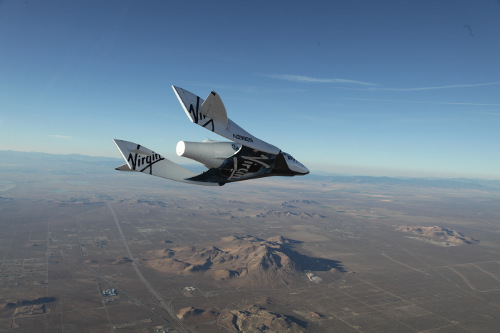 |
| August 04, 2015 | Volume 11 Issue 29 |
Designfax weekly eMagazine
Archives
Partners
Manufacturing Center
Product Spotlight
Modern Applications News
Metalworking Ideas For
Today's Job Shops
Tooling and Production
Strategies for large
metalworking plants
NTSB: Cause of Virgin Galactic SpaceShipTwo in-flight breakup was human error
The National Transportation Safety Board determined the cause of the Oct. 31, 2014, in-flight breakup of SpaceShipTwo was Scaled Composite's failure to consider and protect against human error and the co-pilot's premature unlocking of the spaceship's feather system "as a result of time pressure and vibration and loads that he had not recently experienced."

The first SpaceShipTwo during a glide flight over the Mojave desert. [Image Copyright: Virgin Galactic]
SpaceShipTwo VSS Enterprise was a commercial space vehicle that Scaled Composites built for Virgin Galactic for space tourism. The vehicle was designed to be carried by the Scaled Composites White Knight Two mothership before being released to fly on into the upper atmosphere powered by its own rocket engine. The vehicle broke up during a rocket-powered test flight, seriously injuring the pilot and killing the co-pilot.
The feather system, which was designed to pivot the tailboom structures upward to slow the vehicle during reentry into the Earth's atmosphere, was to be unlocked during the boost phase of flight at a speed of 1.4 Mach. This phase happens shortly after the vehicle detaches from its mothership. The copilot, Michael Alsbury, unlocked the feather at 0.8 Mach; once unlocked, the loads imposed on the feather were sufficient to overcome the feather actuators, allowing the feather to deploy uncommanded, which resulted in the breakup of the vehicle.
Peter Siebold, the pilot on the mission, parachuted to safety.
Britain's "The Guardian" newspaper reported July 28, 2015, "At that [lower] speed, lift from the horizontal tails exceeded the feather actuator's ability to prevent a rapid aerodynamic extension of the feather system. The feather extended rapidly without further pilot action or mechanical malfunction. ... NTSB investigator Katherine Wilson suggested Alsbury might have unlocked the system too early to prevent the flight from being aborted. The feathering system had to be unlocked by Mach 1.8 at the latest, or else the flight would have been aborted."
NPR reported, "The NTSB also said the co-pilot had recently been given more tasks to complete during the flight, and it recommended that more be done to reduce the possibility of human error in similar flights."
Video: How the feathering system should have worked -- Virgin Galactic's exclusive footage of the first SS2 feather flight in glide-only mode, Mojave, CA, May 2011. Filmed by Mobile Aerospace Reconnaissance System (MARS) & The Clay Center Observatory.
The Board found that Scaled Composites failed to consider the possibility that a test pilot could unlock the feather early or that this single-point human error could cause the feather to deploy uncommanded. The Board also found that Scaled Composites failed to ensure that test pilots adequately understood the risks of unlocking the feather early. Investigators found that the only documented discussion with the accident pilots about the loads on the feather as the vehicle transitioned from subsonic to supersonic flight occurred more than three years before the accident.
The Federal Aviation Administration (FAA) was responsible for evaluating Scaled Composites' experimental permit applications for test flights of the vehicle. After granting an initial permit and renewing the permit once, the FAA recognized that Scaled Composites' hazard analysis did not meet the software and human error requirements in FAA regulations for experimental permits. The FAA then waived the hazard analysis requirements related to software and human errors based on mitigations included in Scaled Composites' experimental permit application; however, the FAA subsequently failed to ensure the mitigations in the waiver were being implemented by Scaled.
NTSB Chairman Christopher A. Hart emphasized that consideration of human factors, which was not emphasized in the design, safety assessment, and operation of SpaceShipTwo's feather system, is critical to safe manned spaceflight to mitigate the potential consequences of human error.
"Manned commercial spaceflight is a new frontier, with many unknown risks and hazards," Hart said. "In such an environment, safety margins around known hazards must be rigorously established and, where possible, expanded."
Actual flight: Video shown during NTSB Board Meeting on in-flight breakup of SpaceShipTwo near Mojave, CA, on Oct. 31, 2014, after the ship fired up its rockets.
The Board made recommendations to the Federal Aviation Administration and the Commercial Spaceflight Federation. If acted upon, the recommendations would establish human factors guidance for commercial space operators and strengthen the FAA's evaluation process for experimental permit applications by promoting stronger collaboration between FAA technical staff and operators of commercial space vehicles. "For commercial spaceflight to successfully mature, we must meticulously seek out and mitigate known hazards, as a prerequisite to identifying and mitigating new hazards," Hart said.
A link to the abstract, which contains the findings, probable cause, and recommendations, can be found here.
Source: National Transportation Safety Board
Published August 2015
Rate this article
View our terms of use and privacy policy
